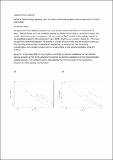Files in this item
Determining pregnancy status in harbour seals using progesterone concentrations in blood and blubber
Item metadata
| dc.contributor.author | Hall, Ailsa Jane | |
| dc.contributor.author | Hewitt, Rebecca | |
| dc.contributor.author | Arso Civil, Monica | |
| dc.date.accessioned | 2021-06-05T23:46:17Z | |
| dc.date.available | 2021-06-05T23:46:17Z | |
| dc.date.issued | 2020-09-01 | |
| dc.identifier | 268553686 | |
| dc.identifier | 3976f5ef-b68b-4972-bc99-4856547533e0 | |
| dc.identifier | 000555112400018 | |
| dc.identifier | 85086450679 | |
| dc.identifier.citation | Hall , A J , Hewitt , R & Arso Civil , M 2020 , ' Determining pregnancy status in harbour seals using progesterone concentrations in blood and blubber ' , General and Comparative Endocrinology , vol. 295 , 113529 . https://doi.org/10.1016/j.ygcen.2020.113529 | en |
| dc.identifier.issn | 0016-6480 | |
| dc.identifier.other | ORCID: /0000-0002-7562-1771/work/75996653 | |
| dc.identifier.other | ORCID: /0000-0001-8239-9526/work/75996858 | |
| dc.identifier.uri | https://hdl.handle.net/10023/23315 | |
| dc.description | Funding: This study was made possible through funding from the UKRI Natural Environment Research Council (grant numbers SMRU10001 and NE/R015007/1), the Scottish Government (grant number MMSS/002/15), Beatrice Offshore Wind Ltd. (BOWL), Moray Offshore Renewables Ltd.(MORL), Marine Scotland Science, The Crown Estate and Highlands andIsland Enterprise. | en |
| dc.description.abstract | Pregnancy status in harbour seals can be estimated from concentrations of progesterone in blubber as well as in blood samples, which are significantly higher in pregnant than non-pregnant animals. This study investigated the accuracy of estimating pregnancy rates using samples from live-captured and released harbour seals from three regions around Scotland, coupled with observed pregnancy outcomes. Concentrations of progesterone in blood (plasma) and blubber were obtained during the capture of animals early in the year (February to May). Individual animals were identified from the unique markings on their pelage, with a proportion (n = 51) of females re-sighted during the subsequent breeding season and the reproductive outcomes determined (pregnant or possibly non-pregnant) during observations from long-term photo-identification studies. Generalised linear models with a binomial link function were fitted to training (60% of the data) and test datasets (40% of the data) to estimate pregnancy status from progesterone concentrations in blubber, plasma or both, and a received operating curves (ROC) approach was used to evaluate the performance of each classifier. The accuracy for the plasma concentrations was 85% with a high classification performance (as estimated from an area under the curve (AUC) of 0.82). The Youden method to determine the cut-point (threshold) and bootstrapping the training dataset resulted in a cut-point of 58 ng ml−1 (95th percentiles, 25–102 ng ml−1). For blubber, the accuracy was 77% (AUC = 0.86) with an optimal cut-point of 56 ng g−1 (95th percentiles, 26–223 ng g−1). In the combined analysis (both blubber and plasma), the accuracy was 87.5% (AUC 0.81) with the cut-points of 72 ng ml−1 (95th percentiles, 25–103 ng ml−1) in plasma and 56 ng g−1 (95th percentiles, 26–223 ng g−1) in blubber. These thresholds were then used to estimate the pregnancy proportions among adult females at the three study sites, including those that were not included in the photo-id studies. Proportions were high at all sites, (63%–100%) regardless of which matrices were used and were not statistically significantly different from each other but suggested that analysing concentrations in both sample matrices would minimise the uncertainty. | |
| dc.format.extent | 7 | |
| dc.format.extent | 315713 | |
| dc.format.extent | 172147 | |
| dc.language.iso | eng | |
| dc.relation.ispartof | General and Comparative Endocrinology | en |
| dc.subject | Reproductive hormones | en |
| dc.subject | Pinnipeds | en |
| dc.subject | Reproduction | en |
| dc.subject | Fecundity | en |
| dc.subject | GC Oceanography | en |
| dc.subject | QH301 Biology | en |
| dc.subject | DAS | en |
| dc.subject.lcc | GC | en |
| dc.subject.lcc | QH301 | en |
| dc.title | Determining pregnancy status in harbour seals using progesterone concentrations in blood and blubber | en |
| dc.type | Journal article | en |
| dc.contributor.sponsor | NERC | en |
| dc.contributor.sponsor | NERC | en |
| dc.contributor.institution | University of St Andrews. School of Biology | en |
| dc.contributor.institution | University of St Andrews. Sea Mammal Research Unit | en |
| dc.contributor.institution | University of St Andrews. Scottish Oceans Institute | en |
| dc.contributor.institution | University of St Andrews. Marine Alliance for Science & Technology Scotland | en |
| dc.identifier.doi | https://doi.org/10.1016/j.ygcen.2020.113529 | |
| dc.description.status | Peer reviewed | en |
| dc.date.embargoedUntil | 2021-06-06 | |
| dc.identifier.grantnumber | Agreement R8-H12-86 | en |
| dc.identifier.grantnumber | NE/R015007/1 | en |
This item appears in the following Collection(s)
Items in the St Andrews Research Repository are protected by copyright, with all rights reserved, unless otherwise indicated.


